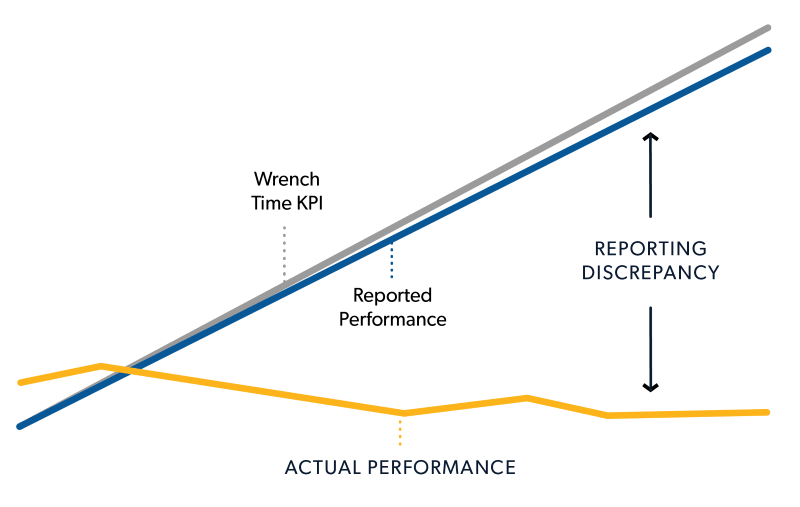These Preventive Maintenance “Best Practices” Could Kill Your Efforts

Many organizations subscribe to commonly held preventive maintenance best practices yet see little difference in unplanned downtime and maintenance costs.
These practices seem common sense, but often result in an unclear maintenance strategy that’s more reactive than preventive.
This article overviews the most common (and unrealized) preventive maintenance best practice myths that could secretly undermine your preventive efforts.
Uncovering these faulty practices in your program will help you concentrate your energy where you’ll have the greatest impact. It will also help you align everything you do to enterprise goals, which is a standard of all world-class preventive maintenance programs.
Preventive Maintenance Best Practice MYTHS:
- All assets are critical
- The more detailed your work orders are, the better
- Measuring wrench time is essential for productivity
- Techs can double as planners or schedulers
All Assets Are Not Critical
Asset criticality refers to how important any asset is to keep business up and running. However, site leaders are prone to label every machine as essential, especially when those assets cost millions of dollars to procure and thousands to repair.The problem is that when every manufacturing, plant or warehouse asset is labeled essential, it becomes impossible to get a clear picture of the criticality of each asset (relative to your other assets) and prioritize your preventive maintenance efforts accordingly.
At the end of the day, if every asset is equally important, nothing is important. There is no way to run an effective asset management or preventive maintenance program without a documented understanding of the relative risk of downtime or failure for each asset.
Most organizations consider more than 50% of their assets critical, which is not realistic for determining priority levels.
Instead, aim to define your 20% most critical assets by documenting each and defining their criticality levels, according to how machine failure will impact production volume, repair costs and other factors you determine are central to meeting organizational goals.
This process of downsizing your critical asset list will help your team:
- Uncover the risk of downtime for each asset (so machine failure won’t blindside your team)
- Understand how each asset supports organizational priorities (e.g., production volume, costs and downtime)
- Prevent your team from falling into reactive mode
- Set you up to implement a truly preventive maintenance program
Overdetailed Work Orders Send the Wrong Message
Once you’ve defined the criticality of each asset, you’ll be able to identify any PMs (i.e., planned maintenance tasks) that are happening too often and eliminate wasted efforts.
From there, you can develop a prioritized work order schedule based on how often you should test each asset (e.g., weekly, monthly, as needed). This will keep your team from spreading thin and falling into reactive mode.
When it comes to individual work orders, a common mistake organizations make is providing too much or not enough detail.
For example, a work order that says “change oil” should detail the kind of oil you need, but it shouldn’t be overly technical and painstakingly detailed. Consider the skill level of your technicians, and create your work orders accordingly.
Here’s a basic process we recommend for improving your work orders:
- Pressure-test existing orders with your techs. You should never create work orders in a vacuum. Consider the people you’re writing them for, and (better yet) talk with them to find out what information might be missing and what’s extraneous.
- Don’t aim for perfection. “Perfect” work orders leave no room for better ones. Your planners need the artistic freedom to version test their work orders. They should also collaborate with your techs to make sure they’re communicating the right information without bogging them down in unneeded details.
- Continually assess and optimize. You’re not aiming for perfection, but you should always aim for better. As site leaders should encourage planners to draft different work orders and experiment with varying levels of detail, your technicians should have the freedom to communicate with schedulers and suggest improvements.
The thread that ties this process together is communication. Your schedulers and planners should work closely to continually improve the quality of your work orders.
You’ll find the tighter the connection between the planner and technicians, the more refined your work orders and the more efficient your PMs will become.
Measuring Wrench Time Is Counterproductive
Another mechanism site leaders use (often incorrectly) to improve performance is wrench time management. Wrench time (also referred to as tool time) is a maintenance metric that measures the amount of time technicians spend performing work on a piece of equipment as part of the total time it takes to complete a job.
Wrench time seems fairly straightforward and quantitative, so many site leaders uphold it as a cornerstone of productivity. Yet there are many challenges that come with assessing wrench time. Understanding them can help you avoid unintended productivity downfalls.
Measuring wrench time, like all forms of measurement, is essentially flawed. You’ll never be able to measure every little process and activity. Aiming to do so carries counterproductive consequences.
Wrench time holds steady at 25–35% for most organizations. And the traditional thinking goes: If wrench time increases, productivity will improve.
While this is true, the commonly held practice of getting there is flawed.
Most organizations believe if they increase the wrench time metrics they’re holding technicians to, improved performance will naturally follow.
Yet contrary to expectations, wrench time key performance indicators (KPIs) and performance do not usually hold a proportional relationship (where actual wrench time increases alongside performance metrics).
There are two reasons for this:
- When technicians feel pressured to meet modified KPIs, they’re prone to become overly nervous over small delays and develop performance anxiety.
- Many delays are unavoidable, so technicians are more likely to inaccurately report wrench time to meet performance expectations on paper.
These problems diminish performance and are intensified when you observe technicians closely (i.e., micromanage) to verify reporting. It brings feelings of unease and job dissatisfaction.
For these reasons, as your wrench time KPIs increase (from 25% to 35% to 45% for example), actual performance tends to dwindle, which can look something like this:
Inflated KPIs, Diminished Performance & Reporting Discrepancies

Wrench time KPIs and actual performance often hold an inversely proportional relationship. As wrench time KPIs increase, performance decreases, and reporting discrepancies manifest.
Wrench Time Monitoring and Reporting Discrepancies
At the end of the day, painstaking efforts to measure productivity inadvertently yield diminishing returns on both performance and reporting accuracy. This is because self reporting on wrench time is usually wrought with error, and (as noted above) observing wrench time can make matters worse.
While most organizations can aim to have a general read on how long maintenance tasks take, upholding wrench time as a pivotal performance standard can bring undesirable consequences.
In some cases, it might be best to leave wrench time metrics behind. Instead, use your time to uncover and implement process efficiencies.
If you do choose to measure, be aware of the risks, and set achievable KPIs that fairly consider the unavoidable downtime your technicians will encounter.
Technicians Are Not Planners
While wrench time metrics often fail to deliver, one of the best ways to improve performance is to optimize preventive maintenance planning and scheduling.
Many organizations undercut their ability to do so by choosing to have technicians double as planners. Unfortunately, whatever this choice gains in employment savings, the business invariably loses in downtime, which threatens production and revenue goals. Doubling up these roles also makes it impossible to run a preventive program.
This is because technicians handle the tasks that need to be acted on now. Planners, on the other hand, must be future-focused, always considering which work orders should be executed in the coming weeks and months (based on asset criticality guidelines and organizational goals).
This future focus becomes impossible when technicians are running around the factory, putting out fires as they arise, which could have likely been averted if a scheduler were tasked to the job of preventing them.
When a scheduler is not assigned to plan and orchestrate work orders, make sure critical spare parts are on hand and foresee future downtime and failures, your machines will schedule the work for you by breaking down unexpectedly, in which case every week might feel like an emergency.
Avoid the Paradox of Preventive Maintenance “Best Practices”
The secret to impactful preventive maintenance best practices does not lie in the individual work orders and job plans you churn out. It’s your overarching commitment to a future-focused preventive program.
Unfortunately, many so-called preventive maintenance best practices paradoxically get in the way of running a truly preventive program. Uncovering these misguided processes will help you unlock a new level of impact in your preventive maintenance program.
If you’re looking for preventive or building maintenance services that will help you implement a program that’s based on world-class maintenance principles, contact us today.



